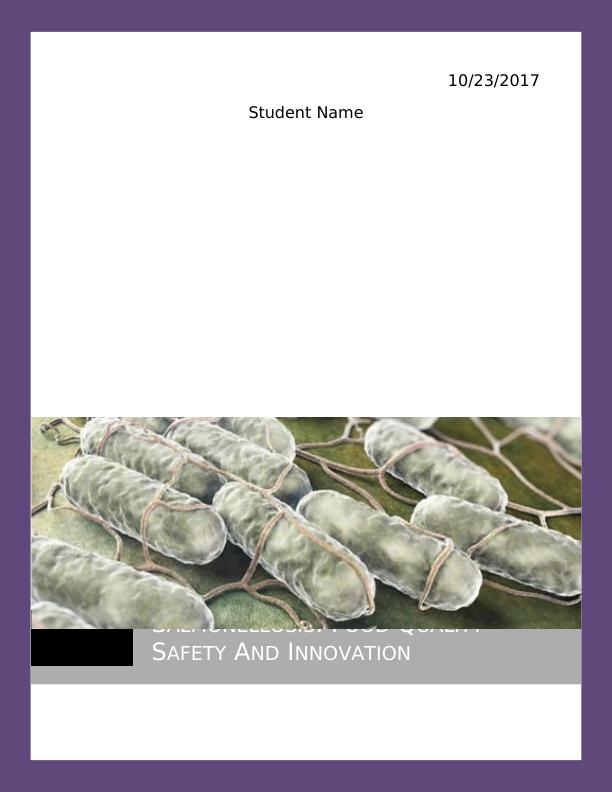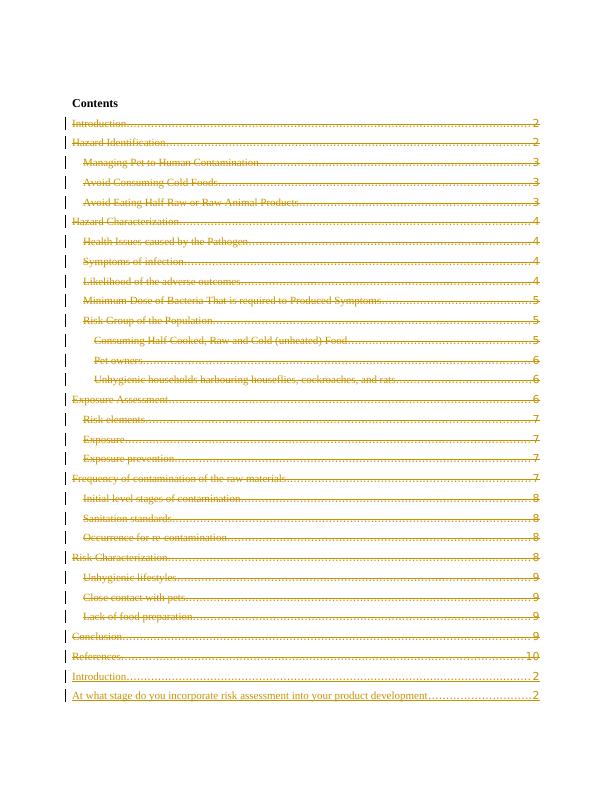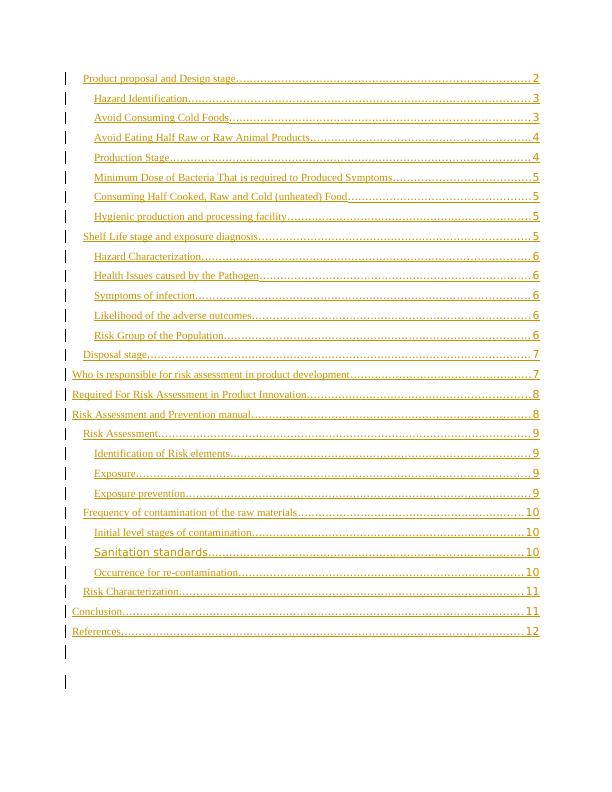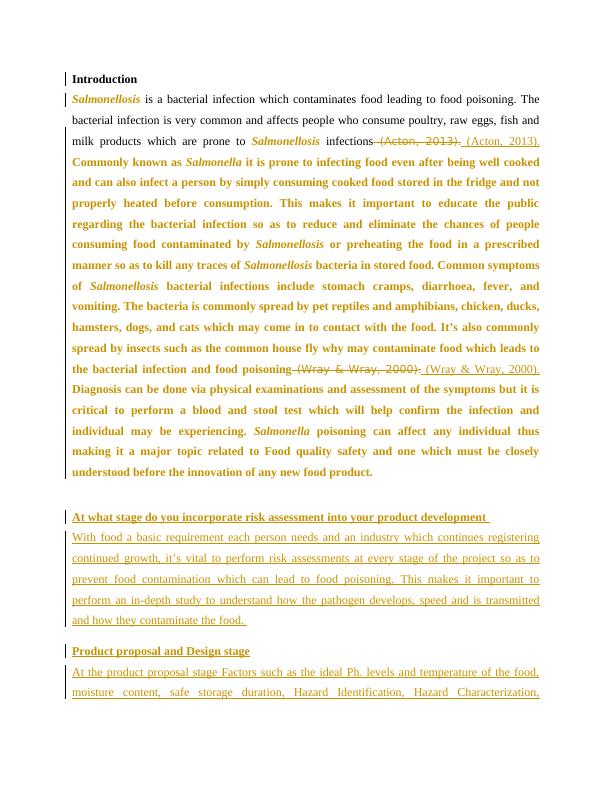Report on Salmonellosis: Food Quality Safety And Innovation
19 Pages4628 Words30 Views
Added on 2020-05-01
Report on Salmonellosis: Food Quality Safety And Innovation
Added on 2020-05-01
ShareRelated Documents
10/23/2017
Student Name
SALMONELLOSIS: FOOD QUALITY
SAFETY AND INNOVATION
Student Name
SALMONELLOSIS: FOOD QUALITY
SAFETY AND INNOVATION

Contents
Introduction.................................................................................................................... 2
Hazard Identification........................................................................................................ 2
Managing Pet to Human Contamination.............................................................................. 3
Avoid Consuming Cold Foods......................................................................................... 3
Avoid Eating Half Raw or Raw Animal Products..................................................................3
Hazard Characterization.................................................................................................... 4
Health Issues caused by the Pathogen................................................................................. 4
Symptoms of infection................................................................................................... 4
Likelihood of the adverse outcomes...................................................................................4
Minimum Dose of Bacteria That is required to Produced Symptoms...........................................5
Risk Group of the Population........................................................................................... 5
Consuming Half Cooked, Raw and Cold (unheated) Food....................................................5
Pet owners............................................................................................................... 6
Unhygienic households harbouring houseflies, cockroaches, and rats.......................................6
Exposure Assessment........................................................................................................ 6
Risk elements.............................................................................................................. 7
Exposure.................................................................................................................... 7
Exposure prevention...................................................................................................... 7
Frequency of contamination of the raw materials......................................................................7
Initial level stages of contamination...................................................................................8
Sanitation standards....................................................................................................... 8
Occurrence for re-contamination....................................................................................... 8
Risk Characterization........................................................................................................ 8
Unhygienic lifestyles..................................................................................................... 9
Close contact with pets................................................................................................... 9
Lack of food preparation................................................................................................. 9
Conclusion..................................................................................................................... 9
References................................................................................................................... 10
Introduction.................................................................................................................... 2
At what stage do you incorporate risk assessment into your product development.............................2
Introduction.................................................................................................................... 2
Hazard Identification........................................................................................................ 2
Managing Pet to Human Contamination.............................................................................. 3
Avoid Consuming Cold Foods......................................................................................... 3
Avoid Eating Half Raw or Raw Animal Products..................................................................3
Hazard Characterization.................................................................................................... 4
Health Issues caused by the Pathogen................................................................................. 4
Symptoms of infection................................................................................................... 4
Likelihood of the adverse outcomes...................................................................................4
Minimum Dose of Bacteria That is required to Produced Symptoms...........................................5
Risk Group of the Population........................................................................................... 5
Consuming Half Cooked, Raw and Cold (unheated) Food....................................................5
Pet owners............................................................................................................... 6
Unhygienic households harbouring houseflies, cockroaches, and rats.......................................6
Exposure Assessment........................................................................................................ 6
Risk elements.............................................................................................................. 7
Exposure.................................................................................................................... 7
Exposure prevention...................................................................................................... 7
Frequency of contamination of the raw materials......................................................................7
Initial level stages of contamination...................................................................................8
Sanitation standards....................................................................................................... 8
Occurrence for re-contamination....................................................................................... 8
Risk Characterization........................................................................................................ 8
Unhygienic lifestyles..................................................................................................... 9
Close contact with pets................................................................................................... 9
Lack of food preparation................................................................................................. 9
Conclusion..................................................................................................................... 9
References................................................................................................................... 10
Introduction.................................................................................................................... 2
At what stage do you incorporate risk assessment into your product development.............................2

Product proposal and Design stage.................................................................................... 2
Hazard Identification.................................................................................................. 3
Avoid Consuming Cold Foods...................................................................................... 3
Avoid Eating Half Raw or Raw Animal Products...............................................................4
Production Stage....................................................................................................... 4
Minimum Dose of Bacteria That is required to Produced Symptoms.......................................5
Consuming Half Cooked, Raw and Cold (unheated) Food....................................................5
Hygienic production and processing facility......................................................................5
Shelf Life stage and exposure diagnosis.............................................................................. 5
Hazard Characterization.............................................................................................. 6
Health Issues caused by the Pathogen.............................................................................. 6
Symptoms of infection................................................................................................ 6
Likelihood of the adverse outcomes................................................................................6
Risk Group of the Population........................................................................................ 6
Disposal stage.............................................................................................................. 7
Who is responsible for risk assessment in product development....................................................7
Required For Risk Assessment in Product Innovation................................................................8
Risk Assessment and Prevention manual................................................................................8
Risk Assessment........................................................................................................... 9
Identification of Risk elements...................................................................................... 9
Exposure................................................................................................................. 9
Exposure prevention................................................................................................... 9
Frequency of contamination of the raw materials.................................................................10
Initial level stages of contamination..............................................................................10
Sanitation standards.......................................................................................... 10
Occurrence for re-contamination.................................................................................. 10
Risk Characterization................................................................................................... 11
Conclusion................................................................................................................... 11
References................................................................................................................... 12
Hazard Identification.................................................................................................. 3
Avoid Consuming Cold Foods...................................................................................... 3
Avoid Eating Half Raw or Raw Animal Products...............................................................4
Production Stage....................................................................................................... 4
Minimum Dose of Bacteria That is required to Produced Symptoms.......................................5
Consuming Half Cooked, Raw and Cold (unheated) Food....................................................5
Hygienic production and processing facility......................................................................5
Shelf Life stage and exposure diagnosis.............................................................................. 5
Hazard Characterization.............................................................................................. 6
Health Issues caused by the Pathogen.............................................................................. 6
Symptoms of infection................................................................................................ 6
Likelihood of the adverse outcomes................................................................................6
Risk Group of the Population........................................................................................ 6
Disposal stage.............................................................................................................. 7
Who is responsible for risk assessment in product development....................................................7
Required For Risk Assessment in Product Innovation................................................................8
Risk Assessment and Prevention manual................................................................................8
Risk Assessment........................................................................................................... 9
Identification of Risk elements...................................................................................... 9
Exposure................................................................................................................. 9
Exposure prevention................................................................................................... 9
Frequency of contamination of the raw materials.................................................................10
Initial level stages of contamination..............................................................................10
Sanitation standards.......................................................................................... 10
Occurrence for re-contamination.................................................................................. 10
Risk Characterization................................................................................................... 11
Conclusion................................................................................................................... 11
References................................................................................................................... 12

Introduction
Salmonellosis is a bacterial infection which contaminates food leading to food poisoning. The
bacterial infection is very common and affects people who consume poultry, raw eggs, fish and
milk products which are prone to Salmonellosis infections (Acton, 2013). (Acton, 2013).
Commonly known as Salmonella it is prone to infecting food even after being well cooked
and can also infect a person by simply consuming cooked food stored in the fridge and not
properly heated before consumption. This makes it important to educate the public
regarding the bacterial infection so as to reduce and eliminate the chances of people
consuming food contaminated by Salmonellosis or preheating the food in a prescribed
manner so as to kill any traces of Salmonellosis bacteria in stored food. Common symptoms
of Salmonellosis bacterial infections include stomach cramps, diarrhoea, fever, and
vomiting. The bacteria is commonly spread by pet reptiles and amphibians, chicken, ducks,
hamsters, dogs, and cats which may come in to contact with the food. It’s also commonly
spread by insects such as the common house fly why may contaminate food which leads to
the bacterial infection and food poisoning (Wray & Wray, 2000). (Wray & Wray, 2000).
Diagnosis can be done via physical examinations and assessment of the symptoms but it is
critical to perform a blood and stool test which will help confirm the infection and
individual may be experiencing. Salmonella poisoning can affect any individual thus
making it a major topic related to Food quality safety and one which must be closely
understood before the innovation of any new food product.
At what stage do you incorporate risk assessment into your product development
With food a basic requirement each person needs and an industry which continues registering
continued growth, it’s vital to perform risk assessments at every stage of the project so as to
prevent food contamination which can lead to food poisoning. This makes it important to
perform an in-depth study to understand how the pathogen develops, speed and is transmitted
and how they contaminate the food.
Product proposal and Design stage
At the product proposal stage Factors such as the ideal Ph. levels and temperature of the food,
moisture content, safe storage duration, Hazard Identification, Hazard Characterization,
Salmonellosis is a bacterial infection which contaminates food leading to food poisoning. The
bacterial infection is very common and affects people who consume poultry, raw eggs, fish and
milk products which are prone to Salmonellosis infections (Acton, 2013). (Acton, 2013).
Commonly known as Salmonella it is prone to infecting food even after being well cooked
and can also infect a person by simply consuming cooked food stored in the fridge and not
properly heated before consumption. This makes it important to educate the public
regarding the bacterial infection so as to reduce and eliminate the chances of people
consuming food contaminated by Salmonellosis or preheating the food in a prescribed
manner so as to kill any traces of Salmonellosis bacteria in stored food. Common symptoms
of Salmonellosis bacterial infections include stomach cramps, diarrhoea, fever, and
vomiting. The bacteria is commonly spread by pet reptiles and amphibians, chicken, ducks,
hamsters, dogs, and cats which may come in to contact with the food. It’s also commonly
spread by insects such as the common house fly why may contaminate food which leads to
the bacterial infection and food poisoning (Wray & Wray, 2000). (Wray & Wray, 2000).
Diagnosis can be done via physical examinations and assessment of the symptoms but it is
critical to perform a blood and stool test which will help confirm the infection and
individual may be experiencing. Salmonella poisoning can affect any individual thus
making it a major topic related to Food quality safety and one which must be closely
understood before the innovation of any new food product.
At what stage do you incorporate risk assessment into your product development
With food a basic requirement each person needs and an industry which continues registering
continued growth, it’s vital to perform risk assessments at every stage of the project so as to
prevent food contamination which can lead to food poisoning. This makes it important to
perform an in-depth study to understand how the pathogen develops, speed and is transmitted
and how they contaminate the food.
Product proposal and Design stage
At the product proposal stage Factors such as the ideal Ph. levels and temperature of the food,
moisture content, safe storage duration, Hazard Identification, Hazard Characterization,

End of preview
Want to access all the pages? Upload your documents or become a member.
Related Documents
Food Safety Management Assignmentlg...
|14
|4524
|214
Food Poisoning : Assignmentlg...
|1
|1848
|66
Risk and Crisis Managementlg...
|6
|1458
|38
Study on Salmonella Typhimurium Bacteria: Reportlg...
|7
|1955
|50
Control Measures to Prevent Physical and Chemical Contamination of Foodlg...
|18
|728
|34
Food Safety Managementlg...
|17
|664
|92
